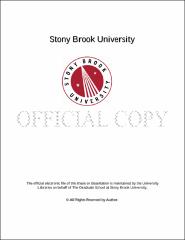| dc.identifier.uri | http://hdl.handle.net/11401/76782 | |
| dc.description.sponsorship | This work is sponsored by the Stony Brook University Graduate School in compliance with the requirements for completion of degree. | en_US |
| dc.format | Monograph | |
| dc.format.medium | Electronic Resource | en_US |
| dc.language.iso | en_US | |
| dc.publisher | The Graduate School, Stony Brook University: Stony Brook, NY. | |
| dc.type | Dissertation | |
| dcterms.abstract | This dissertation describes the conceptual framework and the materialization of the exhibition I guest-curated at the American Folk Art Museum, Folk Couture: Fashion and Folk Art. Based on the tradition of artists using fashion to produce artworks, (for instance, Sylvie Fleury’s installation Poison, which commented upon issues of consumerism); couturiers appropriating images from art to create garments (such as Yves Saint Laurent’s Mondrian Dress, in which the designer replicated a painting made by the Russian constructivist artist), and collaborations between fashion designers and artists (for example, designer Marc Jacobs’s and artist Yayoi Kusama’s collaboration for Louis Vuitton), thirteen New York fashion makers were invited to create ensembles inspired by the American Folk Art Museum’s collection. Both fashion—associated with the feminine and corporality in Western Culture—and folk art—made by the self-trained and not preoccupied with conceptual discourses—have been peripheral to mainstream narratives of art. In the last decades, however, scholars and curators have begun to rethink the artistic “status†of both fashion and folk art. The blockbuster exhibition Alexander McQueen: Savage Beauty held at the Metropolitan Museum of Art, which is considered crucial in the current phenomena of showcasing fashions in art museums, demonstrated the relevance of fashion in contemporary culture. Likewise, folk art has recently become more accepted in the contemporary art sphere. In 2013, curator Massimiliano Gionni included a work called the Palazzo Enciclopledico, (The Encyclopedic Palace) by the self-taught artist Marino Auriti as the centerpiece of the 55th Venice Biennale. It is in the spirit of such developments that the exhibition Folk Couture operated. This dissertation postulates that by echoing the move of fashion and folk art from “periphery to center†in contemporary cultural practices, and exploring the boundaries between artistic disciplines, the major contribution of the exhibition Folk Couture was to exhibit together two ‘outsiders’ of mainstream art—namely fashion and folk art. | |
| dcterms.available | 2017-09-20T16:51:10Z | |
| dcterms.contributor | Lee, Sohl | en_US |
| dcterms.contributor | Munich, Adrienne | en_US |
| dcterms.contributor | Stutesman, Drake. | en_US |
| dcterms.contributor | Patterson, Zabet | en_US |
| dcterms.creator | Carreno, Alexis | |
| dcterms.dateAccepted | 2017-09-20T16:51:10Z | |
| dcterms.dateSubmitted | 2017-09-20T16:51:10Z | |
| dcterms.description | Department of Art History and Criticism. | en_US |
| dcterms.extent | 242 pg. | en_US |
| dcterms.format | Application/PDF | en_US |
| dcterms.format | Monograph | |
| dcterms.identifier | http://hdl.handle.net/11401/76782 | |
| dcterms.issued | 2015-12-01 | |
| dcterms.language | en_US | |
| dcterms.provenance | Made available in DSpace on 2017-09-20T16:51:10Z (GMT). No. of bitstreams: 1
Carreno_grad.sunysb_0771E_12317.pdf: 6062105 bytes, checksum: 187422cc47015eb227ba5b8d1b9ab52d (MD5)
Previous issue date: 1 | en |
| dcterms.publisher | The Graduate School, Stony Brook University: Stony Brook, NY. | |
| dcterms.subject | Fashion, Fashion Exhibitions, Folk art, Museums | |
| dcterms.subject | Art history | |
| dcterms.title | Folk Couture: A Fashion Exhibition at the American Folk Art Museum | |
| dcterms.type | Dissertation | |

